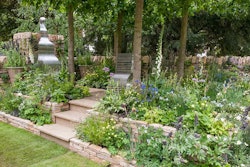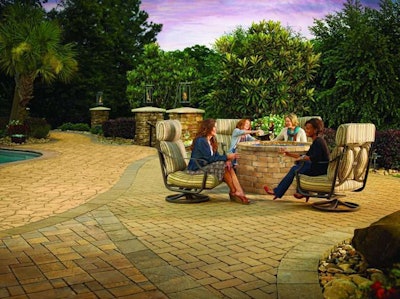 “We think it’s something deeper than just a pretty space,” says Joe Raboine, director of Belgard Design Studio. “People want to be connected and we think that’s driving the trend.”
“We think it’s something deeper than just a pretty space,” says Joe Raboine, director of Belgard Design Studio. “People want to be connected and we think that’s driving the trend.”Photo: Belgard
Having a patio in the backyard is about as commonplace as a sprawling green lawn, but in recent years their designs have been anything but average.
Despite the fact that patios are a quintessential piece for most outdoor living spaces, this doesn’t mean that just anyone can design and install them correctly. While it’s common for homeowners to not know what all is involved, sometimes even landscape contractors can underestimate the price and complexity a patio install can entail.
“If they’ve just been doing maintenance, they need to understand the local codes, setbacks and get a network of subcontractors prior to getting into all these projects,” says Joe Raboine, director of Belgard Design Studio. “Sometimes they can get caught in the middle of things and people get upset but they can avoid that if they do their homework upfront.”
Design inspiration
Just like any other landscaping project, before you can start installing a patio you need to craft a design.
For David Kopfmann, owner and lead designer of Yardscapes based in Bloomington, Minnesota, he draws a lot of his design inspiration for the patio from the architecture of the home.
“The patio is also a hard surface and is attached to the home so the house is part of the inspiration of how the texture would be and you need to pay attention to what room it’s coming out of,” he says. “Is it coming out of the dining area or the rec room? When the door opens, it should make a continuation; that’s the driving force of it.”
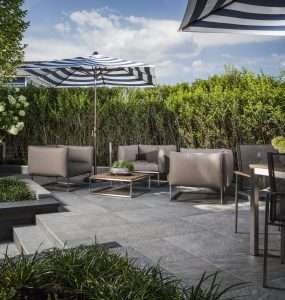 Porcelain pavers can suit both traditional and contemporary designs.
Porcelain pavers can suit both traditional and contemporary designs.Photo: Belgard
Traditional homes are more likely to feature natural stone and have an organic design, while contemporary buildings look better with sharp clean lines and slick hardscaping like porcelain pavers.
Raboine agrees that the architecture of the house is important for creating a space that matches the house.
“A lot of times designers are good at incorporating elements, but sometimes they don’t pay attention to the design of the house,” he says.
Another important design factor is understanding how the client wants to use the space, as this will help dictate the size and the flow as well as whether shade structures need to be included.
“Basically, I’m listening to our clients’ needs,” says Blaine McAulay, senior designer for Graham Landscape & Design based in Eugene, Oregon. “A lot of the times it’s a problem that needs to be solved. You’re given criteria and you create a design that solves a problem.”
Because patios are prevalent in outdoor landscape design, it can be easy to fall into a rut. This isn’t necessarily a bad thing because you can become more efficient if you’re mostly doing the same thing, but you do need to remember the homeowners.
“Try to look at every job as a stand-alone job,” Raboine says. “It’s just another project for a designer, but for a homeowner it’s a huge deal. Try to give them something unique and tailored to them.”
The key to creating a patio that is one-of-a-kind for each client is to listen to them. Ask more questions than simply how big and where do they want it. Getting to know the client and listening to their wants and needs will help you craft a space that is ideal for them.
Hardscaping materials
A customer’s budget is mostly going to dictate what sort of hardscaping materials you can use, but this doesn’t mean you can’t create some stunning designs with cheaper products.
It is better to create an efficient space made of a less expensive material than a tiny, unusable area that happens to have some gorgeous bluestone.
“As an industry we’re guilty of this, we think people are buying spaces because of the product, but it’s because of the experience, not the material itself,” Raboine says. “You can put a less expensive stone in a great design and it can still look phenomenal.”
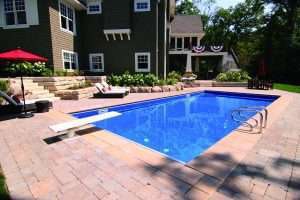 Using different hardscaping material can help highlight a design’s edge.
Using different hardscaping material can help highlight a design’s edge.Photo: Yardscapes
For those who have clients more on the high end, porcelain pavers are becoming quite popular thanks to their durability and versatility.
“I don’t think they’re going away anytime soon,” Raboine says. “A lot of it is driven by their wood grain textures that are difficult to get with concrete.”
Bluestone, travertine and concrete pavers are other popular materials for patio installs. Bluestone can help a patio look timeless, but it does tend to heat up during the hot days so it might not be the best for those clients who enjoy going barefoot a lot. Travertine has a lighter color and doesn’t have this problem.
“When you get down to pavers, with a client it’s not the shape as much as the color,” Kopfmann says. “I might like a paver for the shape and the quality. They don’t notice the shape but the color.”
The mixing of more than one hardscaping material can help create some visual interest by using a different type of stone to highlight the edges of a design. When doing pattern designs it’s important to know where the furniture will be placed so the great arrangement doesn’t end up getting completely covered up.
Another up and coming hardscaping material is permeable paving. Certain areas, like the Chesapeake Bay, are more passionate about this option than others, but most are simply unaware of it. Yardscapes often uses permeable pavers automatically because it allows them to not have to slope the patio as hard.
“We think it’s going to continue to grow on the residential side, and we’re offering more products for residential design,” Raboine says. “A lot of people say they don’t like the look of permeable pavers but you can’t tell the difference nowadays.”
Common challenges
Drainage is one of the major issues landscapers will face when creating a patio due to the fact that level flat surfaces are few and far between in most regions.
Along with drainage, it is important to take into consideration factors like changing elevations, the transition from the house, where the sun will hit portions of it and where are the underground utilities. The more extravagant features the client is asking for the more complex the design, including gas lines and wiring.
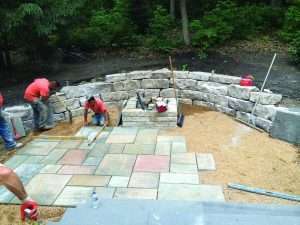 Installing a patio correctly is crucial to ensuring its longevity.
Installing a patio correctly is crucial to ensuring its longevity.Photo: Yardscapes
One task that is crucial for doing a patio right is making sure that your crews prepare the soil properly. No matter how good the product is on top, if the base is done incorrectly it will appear in the long run.
“If they don’t compact it properly or create drainage, then the freeze frost will cause it to move,” Kopfmann says. “Make sure it’s compacted and drains away from the patio area. If not done properly it will cause the patio to fail.”
Space is another major problem designers can face. If they fail to communicate with the customer what sort of furniture they are wanting, they can end up making a portion too small for the double chaise lounge that they planned to put there.
“As a designer, it’s our job to understand what the underlying desire is for that space,” Raboine says. “On some level they can get hung up on the products, asking do you want a fire place or this specific brick, but then we miss the point why they’re buying these spaces. They want to improve their lives with these spaces.”

